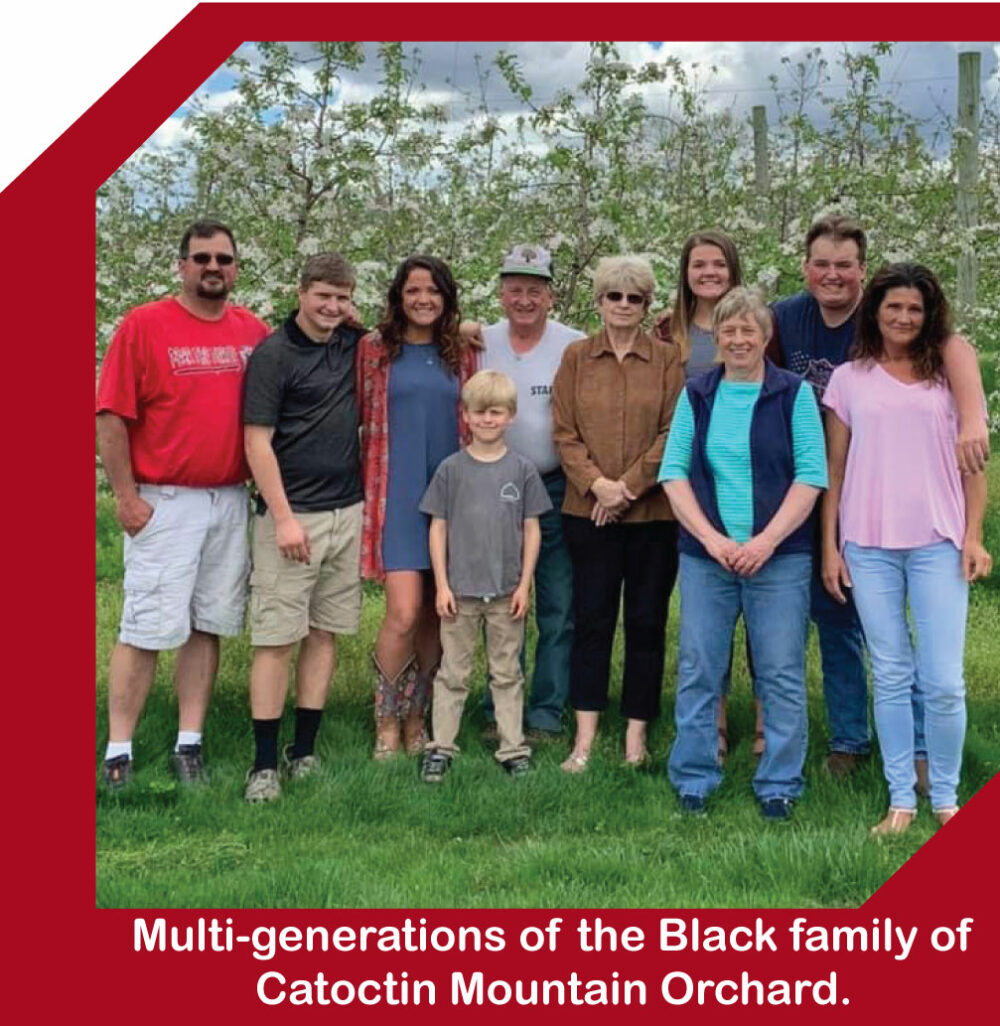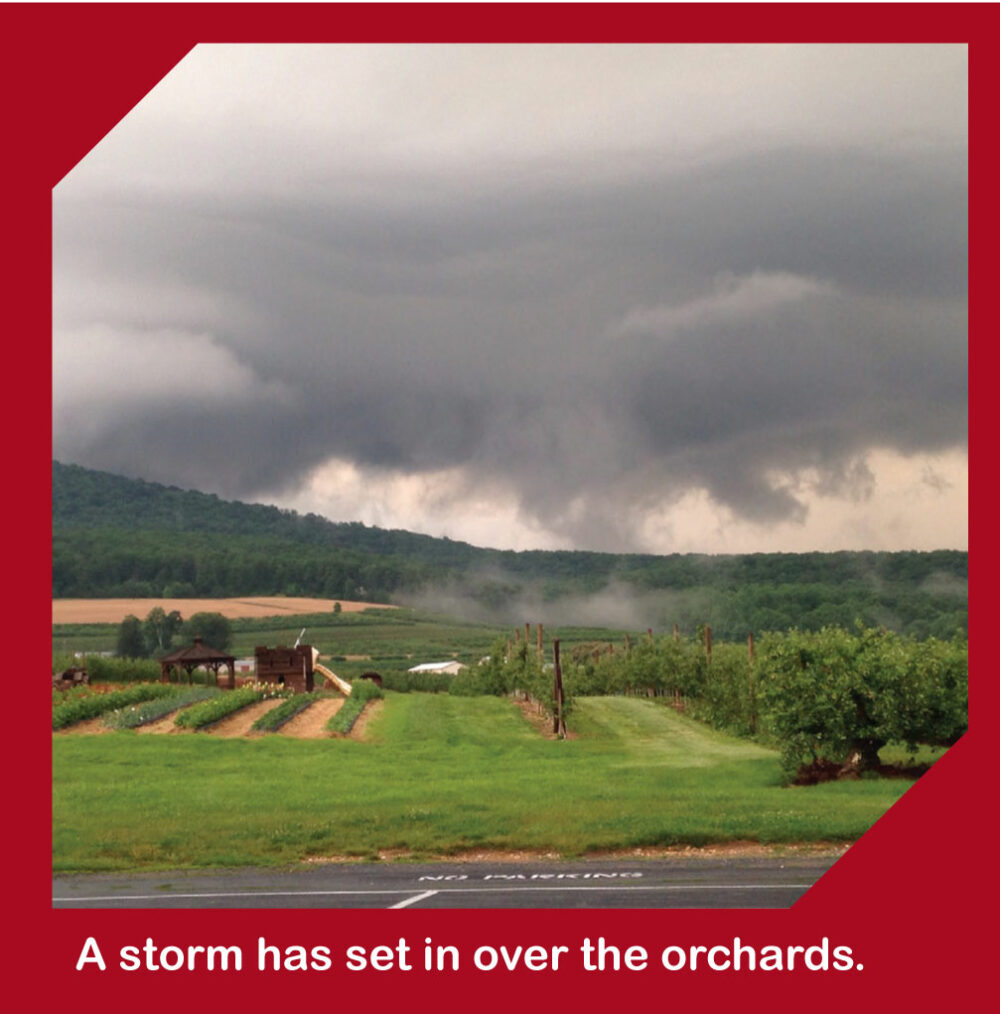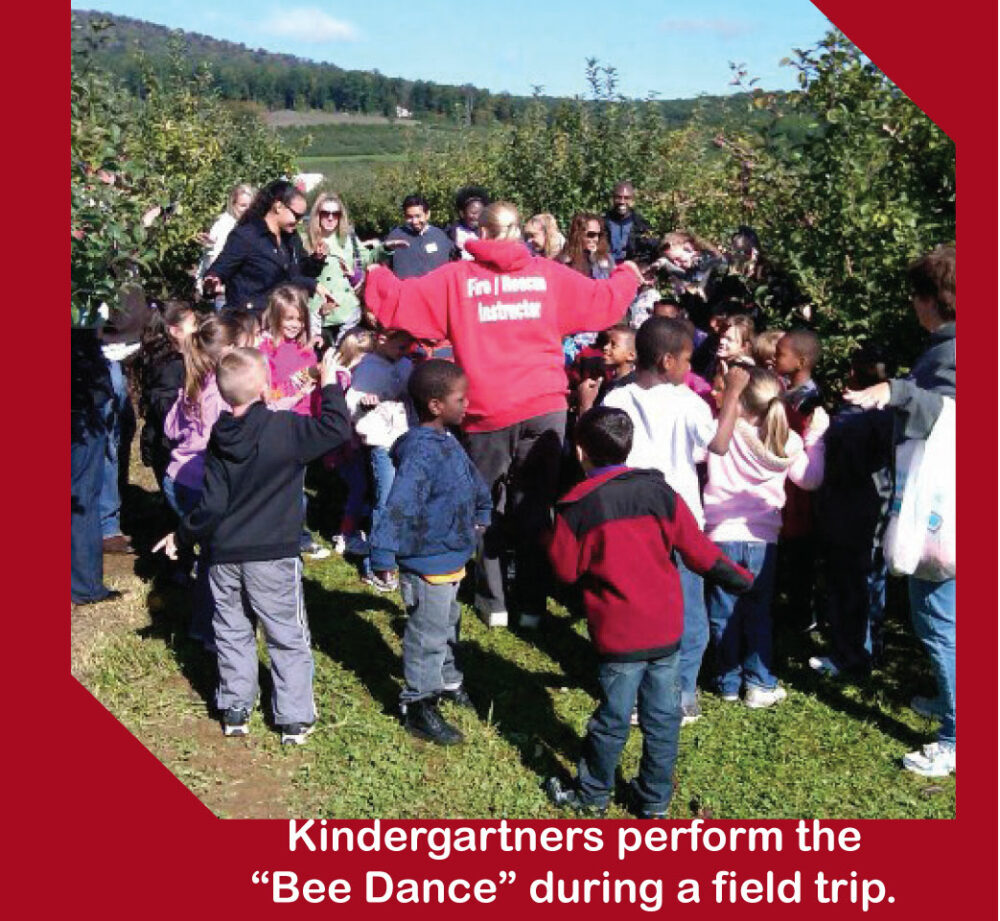Deb Abraham Spalding
Elmer “Lee” Black was born January 31, 1923, to Willis G. and Maude Baker Black. Lee was only 14 when his father died unexpectedly. He and his siblings, older brother Harry and younger sister Betty, all learned to work hard to help their mother during the 1930s when times were tough.
Many days were spent picking green beans at the Zentz Farm (now Rodman Myers’ farm pictured in “Focus On Catoctin” on page 44). Lee and Harry built a small chicken coop to raise and sell chickens and eggs. They took care of several beehives to get honey for themselves and sold or bartered it. They cut, split, and sold cords of wood during the winter months for some income. The boys would trap and skin small wildlife to get money for the pelts.
In the 1920s and 1930s, Thurmont had two fruit orchards. Hooker Lewis had one south of Thurmont and Johnny Kelbaugh had one north of Thurmont. Both were just off Route 15. Lee said that before he was born, most farmers and homesteaders had a small orchard of their own.
After graduating from Thurmont High School in 1940, Lee went on to serve in the Army Air Corps during World War II. Discharged in 1945 after earning the rank of staff sergeant, Lee returned home and started a photography business serving Thurmont and Emmitsburg.
He met his wife Frances, at the Monterey Tea House on New Year’s Eve. She was born and raised in Baltimore City. They married in 1949.
Wanting to spend more time outdoors, Lee and Frances bought Hooker Lewis’ Strawberry Field in 1950 and started Blacks Hilltop Orchard. Hooker Lewis had several little orchards around Thurmont. Lee said, “During World War II and right after – nearly everyone who had an apple tree could make money from it. But after the war, you had to be good at making an orchard to stay in business.”
Lewis’ Orchard, Pryor’s Orchard, and the original Kelbaugh Orchard were the main orchards in the area. Over the years, different people bought parts of Kelbaugh’s Orchard. Russel Flanagan, who had been a mason, quit and went into the orchard business. Right after the war, Hooker Lewis’ son-in-law opened an orchard now known as Pryor’s Orchard. Galen Pryor of Pryor’s Orchard is Hooker Lewis’ great-grandson.
Lee enjoyed the independence of owning an orchard. All of his and Frances’ six children worked the orchard by picking and thinning fruit.
Ira Kelbaugh, son of Johnny Kelbaugh, planted an orchard along Kelbaugh Road. Lee’s brother, Harry, worked for Ira during the war. When Ira semi-retired, he told Harry he would sell him the orchard. For years, Harry took care of the orchard for half the profit and eventually bought it.
This purchase included the roadside market that was very small at the time. Lee said, “When Kelbaugh first started, he didn’t sell fruit along the road. It wasn’t until the highway came through that the market was built around 1948.”
Harry and Lee now owned orchards. Harry said to Lee, “You take care of the picking, and I’ll take care of the selling.” Lee reminisced, “We added pick-your-own black raspberries that he (Harry) raised and strawberries that we raised. There were a lot of problems along the way, I’m sure he disagreed with me and I disagreed with him, but we never had an argument.”
A regional University Of Maryland Extension man named Charlie Dunbar told Harry to build a retail market and to pack baskets with “good fruit!” Most fruit stands or “hucksters” at the time would place seconds (bruised or spotty fruit) in the bottom of a basket and top it off with good fruit! Lee and Harry used good fruit throughout and Lee claimed that was the foundation for both of their farms to become successful businesses.
There wasn’t any place that sold good peaches and apples between Thurmont and Washington, D.C., so, when they first opened, they had more business than they could handle. People canned at the time and would load up bushels at a time. The biggest apple growers were in Adams County, Pa., but, Lee said, “That fruit was all bruised up — the workers didn’t care.”
Business was up and down because of the economy and the weather. Lee said that at one point the orchard business was so bad that they started to raise broiler chickens.
The former Blacks Hilltop Orchard was, and Catoctin Mountain Orchard still is, known as “conservation showcase” orchards. Harry’s family and Lee and Frances’ family worked closely with the State of Maryland to implement smart ideas. In doing so, things changed with orchard procedures and standards.
They started to grow smaller trees to save on costs of picking and spraying. While they always used pesticides of some sort, the pesticides became more effective and, over time, made fruit stronger and more vibrant in color. Lee did some budding on trees, but didn’t do any genetics like the Catoctin Mountain Orchard Black family (Harry’s son Robert’s family, and Harry’s daughter, Pat) does today.
The sale of wholesale fruit was big business for the Black families’ orchards in the 1960s and 1970s. They were the first ones in the area to have Cortland Apples.
“When we first started to sell Cortland apples, we had one heck of a time getting rid of them,” recalled Lee. Then they started to promote Cortland apples. He indicated that many Washington, D.C. workers were from New England states, so they advertised that Cortland apples were an “offspring” of the McIntosh variety they ate up north. That started a trend here in northern Maryland.
Lee planted black raspberries between his young apple trees for some early season spending money. He also grew strawberries in the late 1950s. In the 1960s and 1970s, when pick-your-own caught on, Lee’s farm was known as Strawberry Hill with a “Million Dollar View!”
Up on the hill at the Strawberry Fields, Lee had three small ponds that irrigated all of his strawberry fields, peaches, and apples. He said that the strawberries would have burnt up without the water sources.
“The hills are great, but if you don’t have water, the trees won’t perform,” said Robert.
Ironically, Harry built the first pond for swimming, but it had to be used to irrigate the peaches. Lee had watered most of his orchard on Black Road and told Harry he could borrow his irrigation pump and pipe in 1961 since it was really dry at the time. The pond was fed by a good well and spring combination. When they thought the spring had started to go dry, they put in a submergible pump to pump water from the well into the pond. Even though they could still irrigate the peaches, the Blacks feared that they would lose the source of water for the peaches, so they built a second pond that year, pumped both of them dry, built a third, pumped all three dry, then a fourth pond the year after that. Since then, they have had enough water to keep the trees producing a good crop. Building the ponds helped the business and provided a great resource for generations to come.
Today, Robert and his family use trickle irrigation to water the fruit trees, berries, and vegetables. This process uses less water and energy to water only the tree row, thus saving gallons of water by not over-watering. The water source is still coming off of those ponds. The irrigation system is now all piped underground to minimize loss from evaporation.
To battle a frost, Catoctin Mountain Orchard is strategically placed down a slope from the mountain. Since cold sinks to the lowest level, it will keep moving through open fields and then over Route 15.
In the last years that he ran the orchard, Lee had strawberries; however, a hail storm hit that ruined all the fruit. He said they were “devastated.” “Hail is the enemy. The heavy rain can be managed,” stated Lee. They usually advertised pick-your-own strawberries, but did not have any that season.
Insurance allowed for the catastrophic damage; they then had a total freeze-out for peaches in the 1980s. The insurance paid to maintain the farm to stay in business for the following year. However… “An orchard owner doesn’t want claims. They want a crop to stay in business,” said Robert.
Orchard processes are as close to perfect now as they can be in an uncontrolled environment. There’s more technology available. In the earlier years, a soil test was performed occasionally. “Now, we want to know what is in the soil—pH, Calcium, magnesium, zinc, etc. We want to keep the nutrients balanced, so the fruit grows best. We take leaf samples to determine if we’re short in zinc, nitrogen, potassium, phosphorus, sulfur, and so on. If we’re short, we add it to the soil or apply it foliarly to the leaves. It’s like taking a vitamin pill,” stated Robert.
With Integrate Pest Management (IPM), the Blacks monitor bad insects with traps. Good insects eat bad ones. During the time stink bugs were penetrating the orchard, the Blacks went into defensive mode at the orchard. “I almost lived in the tractor spraying,” Robert said, “We didn’t know what to do. When a stink bug bit or penetrated an apple, it wouldn’t be detected for two to three weeks.”
That bug changed the orchard’s whole spray program, since the old spray wasn’t killing the stink bugs. The Blacks had 90-percent damaged fruit in some areas of the farm that was unsalable in 2010. That damaged fruit was used to feed hogs at a neighboring farm.
The USDA runs weekly testing at Catoctin Orchard. In partnership with the Blacks, they are doing an experiment on an acre plot where they are only spraying six targeted trees that have a pheromone (attractant) placed on the outer edge for the stink bugs to draw them to that area.
“We could lose six trees and save a crop. There were 3,000 stink bugs killed on one tree, so we may eventually have sacrificial trees,” Robert said.
About fifteen years ago, Catoctin Mountain Orchard started contracting with the school lunch program, where their apples are used for lunches in Frederick County schools. “It’s wonderful that kids are eating nearly all varieties of our apples. We’re providing them with great eating apples. Prior to that, they were getting Washington State Red Delicious that really aren’t fit to eat,” expressed Robert.
Today, you’ll find all family members— second, third, and fourth generations of the extended Black family—working the orchard and market. It’s a big operation, where everyone plays an important part.
Uncle Elmer Lee passed away November 9, 2015, and was laid to rest in the Eyler’s Valley Chapel cemetery. We hope he’s enjoying a well-deserved rest after his full and well-lived life.





